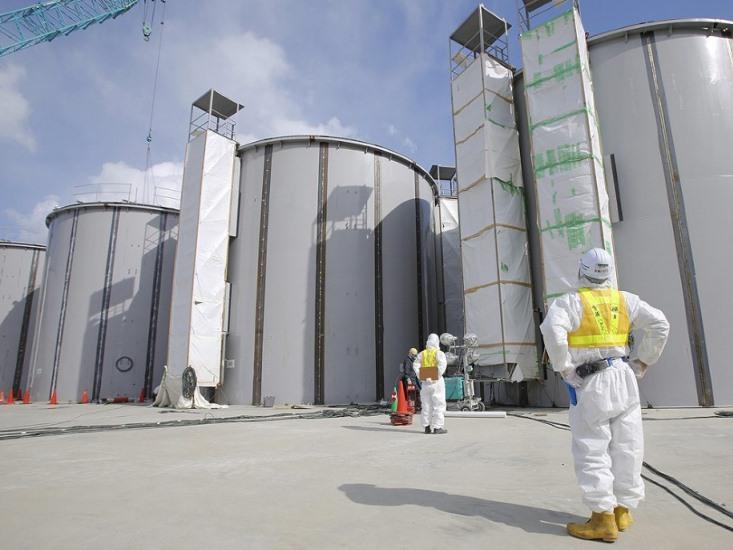This is what passes for good news from Fukushima Daiichi, the Japanese nuclear power plant devastated by meltdowns and explosions after a cataclysmic earthquake and tsunami in 2011: By the end of last month, workers had succeeded in filtering most of the 620,000 tons of toxic water stored at the site, removing almost all of the radioactive materials.
After numerous false starts and technical glitches, most of the stored water has been run through filtration systems to remove dangerous strontium-90, as well as many other radionuclides. TEPCO, the Japanese utility that operates the power plant, trumpeted the achievement: “This is a significant milestone for improving the environment for our surrounding communities and for our workers,” said Naohiro Masuda, TEPCO’s chief decommissioning officer, in a press release.
But it’s not quite so easy to bounce back from a nuclear disaster of this scale. For one thing, don’t take TEPCO’s statement too literally: No one is living in the “surrounding communities”—they’re far too contaminated for human habitation. Furthermore, the filtered water is still full of tritium, a radioactive version of hydrogen. (When two neutrons are added to the element, it becomes unstable, prone to emitting electrons.) Tritium bonds with oxygen just like normal hydrogen does, to produce radioactive “tritiated water.” It’s impractical—or at least extremely difficult and expensive—to separate tritiated water from normal water.
Hence TEPCO’s dilemma—which gets bigger by the day. The enormous volume of water comes from the ongoing need to keep the three melted-down reactor cores cool. More than four years after the disaster, pumps still must pour a constant stream of water into the pressure vessels that contain the radioactive cores. But the meltdowns and explosions rendered those vessels leaky, so TEPCO collects the water that seeps out, as well as rainwater that flows down the hills and through the shattered buildings.
TEPCO has been filling fields with vast arrays of storage tanks to cope with the accumulating water. The company’s 40-year plan for decommissioning the plant calls for the construction of an underground “ice wall” to freeze the soil around the reactor buildings and divert rainwater, and for plugging the leaks in the buildings. But TEPCO has run into problems with the ice wall—the underground tunnels carrying coolant haven’t gotten cold enough to sufficiently freeze the surrounding ground—and the more long-term solution of plugging the reactor buildings’ leaks is still a distant goal. In the meantime, TEPCO keeps building tanks.

Some experts, including the eminently respectable IAEA, have suggested that TEPCO may have to simply dump the tritium-contaminated water into the ocean. Tritium traditionally hasn’t been considered very dangerous to human health. Although tritiated water can reach all parts of the body, like normal water, it’s also expelled quickly from the body, like normal water. If released into the ocean, the contaminated water would quickly be diluted, and it wouldn’t bioaccumulate in fish (unlike strontium-90, for example, which is taken up by bones).
But is tritiated water really so harmless? It’s currently getting a second look from regulators in the United States. Last year, the EPA announced plans to review safety standards for tritiated water, which has leaked from many a nuclear plant. As this excellent Scientific American article explains, there’s considerable uncertainty over whether the stuff is more dangerous than we previously thought.
The amount of tritium in Fukushima Daiichi’s water is not negligible. The World Health Organization’s standard for tritium in drinking water is 10,000 becquerels per liter (34 ounces). According to Mayumi Yoshida, a TEPCO communications officer, Fukushima’s stored water contains between 1 and 5 million becquerels per liter. Yet Yoshida noted that operational nuclear power plants around the world discharge water with a much higher level of tritium than that.
Does that imply that the company is considering discharging its water into the sea, I asked? “Nothing has been decided but to keep storing at the site,” Yoshida said. “We will discuss thoroughly with the government, the oversea and domestic experts, the fishermen, and the surrounding residents, which way would be the safest and the best for everyone, before deciding anything.”
It’s hard to imagine that those discussions will be productive. Releasing the water into the ocean sounds like a non-starter in Japan’s Fukushima prefecture, where fishermen are already furious with TEPCO. Fishing has been suspended around the coastal Fukushima Daiichi plant since the accident, and repeated leaks of radioactive water have angered the fishing associations still further.
If the water can’t be released as-is for political reasons, TEPCO’s only options are to keep building tanks or to accept its extremely difficult and expensive fate, and figure out how to remove the last bit of nuclear taint from its enormous holdings of problematic water.
Eliza Strickland is an associate editor for the science and technology magazine IEEE Spectrum.






























